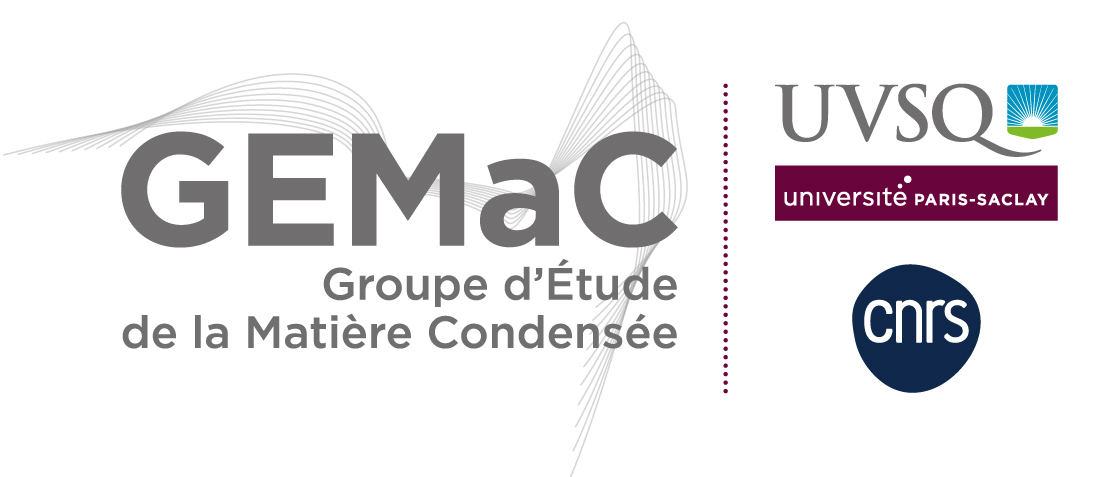Vous êtes ici : GEMACFRSéminaires et colloques
- Partager cette page :
- Version PDF
Quantum networks based on spin-photon interface in quantum dots
le 19 juin 2018
Mardi 19 juin 2018
à 14h
à 14h
GEMaC, salle 4109
Bat. Fermat,
45 avenue des Etats-UnisBat. Fermat,
78035 Versailles cedex
par Aymeric Delteil, Institute of Quantum Electronics, ETH Zurich, 8093 Zurich, Switzerland
Entanglement plays a central role in fundamental tests of quantum mechanics as well as in the burgeoning field of quantum information processing. Particularly in the context of quantum networks and communication, some of the major challenges are the efficient generation of entanglement between distant stationary (spin) qubits, and the transfer of information from flying (photon) to stationary qubits. In this talk, I will present such experimental implementations achieved in our team with semiconductor self-assembled quantum dots.
Not only are self-assembled quantum dots good single-photon emitters, but they can host an electron or a hole whose spin serves as a quantum memory. In that case they present spin-dependent optical selection rules leading to an efficient spin-photon quantum interface. Moreover InGaAs quantum dots grown on GaAs substrate can profit from the maturity of III-V semiconductor technology and can be embedded in semiconductor structures like photonic cavities and Schottky diodes.
I will present the realization of heralded quantum entanglement between two semiconductor quantum dot hole spins separated by more than five meters. The entanglement generation scheme relies on single photon interference of Raman scattered light from both dots [1]. A single photon detection projects the system into a maximally entangled state. The efficient spin-photon interface provided by self-assembled quantum dots [2,3] allows us to reach an unprecedented rate of 2300 entangled spin pairs per second [4], which represents an improvement of three orders of magnitude as compared to prior experiments carried out in other physical systems [5].
I will also report on other recent experimental results such as the demonstration of heralded absorption of single photon qubits –generated from a neutral quantum dot– by a single-electron charged quantum dot 5m away. When the electron spin is initially prepared in a superposition state, our scheme realizes photon-to-spin quantum state transfer, as evidenced by the strong spin-photon correlations we measured [6]. It could be modified to realize for instance spin-to-spin state transfer as well as quantum gates between remote.
These results extend or supplement previous demonstrations in single trapped ions or neutral atoms, in atom ensembles and nitrogen vacancy centres to the domain of artificial atoms in semiconductor nanostructures that allow for on-chip integration of electronic and photonic elements, which has the major advantage of fast spontaneous emission and efficient photon extraction, leading to much higher success rates. This work lays the groundwork for the realization of quantum repeaters and quantum networks on a chip.
[1] C. Cabrillo et al. Phys. Rev. A 59, 1025 (1999)
[2] W.-B. Gao et al., Nature 491, 426 (2012)
[3] A. Delteil et al. Phys. Rev. Lett. 112, 116802 (2014)
[4] A. Delteil et al. Nature Physics 12, 218–223 (2016)
[5] L. Slodička et al., Phys. Rev. Lett. 110, 083603 (2013)
[6] A. Delteil et al. Phys. Rev. Lett. 118, 177401 (2017)
Not only are self-assembled quantum dots good single-photon emitters, but they can host an electron or a hole whose spin serves as a quantum memory. In that case they present spin-dependent optical selection rules leading to an efficient spin-photon quantum interface. Moreover InGaAs quantum dots grown on GaAs substrate can profit from the maturity of III-V semiconductor technology and can be embedded in semiconductor structures like photonic cavities and Schottky diodes.
I will present the realization of heralded quantum entanglement between two semiconductor quantum dot hole spins separated by more than five meters. The entanglement generation scheme relies on single photon interference of Raman scattered light from both dots [1]. A single photon detection projects the system into a maximally entangled state. The efficient spin-photon interface provided by self-assembled quantum dots [2,3] allows us to reach an unprecedented rate of 2300 entangled spin pairs per second [4], which represents an improvement of three orders of magnitude as compared to prior experiments carried out in other physical systems [5].
I will also report on other recent experimental results such as the demonstration of heralded absorption of single photon qubits –generated from a neutral quantum dot– by a single-electron charged quantum dot 5m away. When the electron spin is initially prepared in a superposition state, our scheme realizes photon-to-spin quantum state transfer, as evidenced by the strong spin-photon correlations we measured [6]. It could be modified to realize for instance spin-to-spin state transfer as well as quantum gates between remote.
These results extend or supplement previous demonstrations in single trapped ions or neutral atoms, in atom ensembles and nitrogen vacancy centres to the domain of artificial atoms in semiconductor nanostructures that allow for on-chip integration of electronic and photonic elements, which has the major advantage of fast spontaneous emission and efficient photon extraction, leading to much higher success rates. This work lays the groundwork for the realization of quantum repeaters and quantum networks on a chip.
[1] C. Cabrillo et al. Phys. Rev. A 59, 1025 (1999)
[2] W.-B. Gao et al., Nature 491, 426 (2012)
[3] A. Delteil et al. Phys. Rev. Lett. 112, 116802 (2014)
[4] A. Delteil et al. Nature Physics 12, 218–223 (2016)
[5] L. Slodička et al., Phys. Rev. Lett. 110, 083603 (2013)
[6] A. Delteil et al. Phys. Rev. Lett. 118, 177401 (2017)
- Revenir à la liste complète des séminaires





